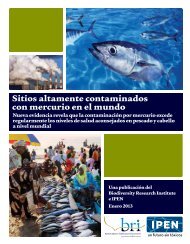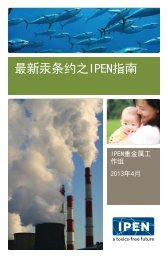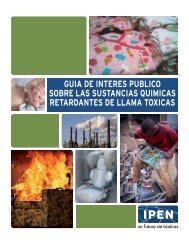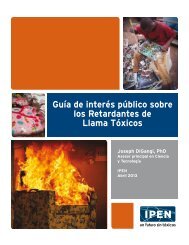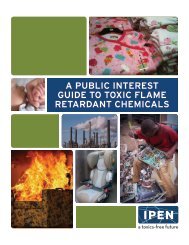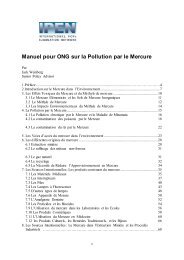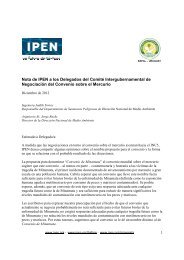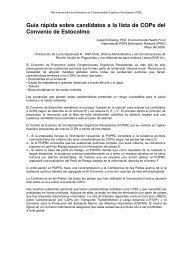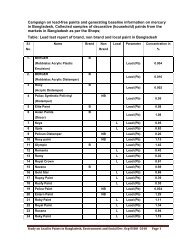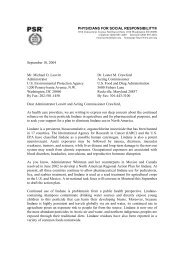The UNDP-GEF POPs Resource Kit - International POPs Elimination ...
The UNDP-GEF POPs Resource Kit - International POPs Elimination ...
The UNDP-GEF POPs Resource Kit - International POPs Elimination ...
You also want an ePaper? Increase the reach of your titles
YUMPU automatically turns print PDFs into web optimized ePapers that Google loves.
UNEP/POPS/CONF/2<br />
Annex C<br />
UNINTENTIONAL PRODUCTION<br />
Part I: Persistent organic pollutants subject to the requirements of Article 5<br />
This Annex applies to the following persistent organic pollutants when formed and released<br />
unintentionally from anthropogenic sources:<br />
Chemical<br />
Polychlorinated dibenzo-p-dioxins and dibenzofurans (PCDD/PCDF)<br />
Hexachlorobenzene (HCB) (CAS No: 118-74-1)<br />
Polychlorinated biphenyls (PCB)<br />
Part II: Source categories<br />
Polychlorinated dibenzo-p-dioxins and dibenzofurans, hexachlorobenzene and polychlorinated biphenyls<br />
are unintentionally formed and released from thermal processes involving organic matter and chlorine as a<br />
result of incomplete combustion or chemical reactions. <strong>The</strong> following industrial source categories have the<br />
potential for comparatively high formation and release of these chemicals to the environment:<br />
(a) Waste incinerators, including co-incinerators of municipal, hazardous or medical waste or of<br />
sewage sludge;<br />
(b) Cement kilns firing hazardous waste;<br />
(c) Production of pulp using elemental chlorine or chemicals generating elemental chlorine for<br />
bleaching;<br />
(d) <strong>The</strong> following thermal processes in the metallurgical industry:<br />
(i) Secondary copper production;<br />
(ii) Sinter plants in the iron and steel industry;<br />
(iii) Secondary aluminium production;<br />
(iv) Secondary zinc production.<br />
Part III: Source categories<br />
Polychlorinated dibenzo-p-dioxins and dibenzofurans, hexachlorobenzene and polychlorinated biphenyls<br />
may also be unintentionally formed and released from the following source categories, including:<br />
(a) Open burning of waste, including burning of landfill sites;<br />
(b) <strong>The</strong>rmal processes in the metallurgical industry not mentioned in Part II;<br />
(c) Residential combustion sources;<br />
(d) Fossil fuel-fired utility and industrial boilers;<br />
(e) Firing installations for wood and other biomass fuels;<br />
82 ----------------------------------------------------------------------------------------<strong>UNDP</strong>-<strong>GEF</strong> <strong>POPs</strong> <strong>Resource</strong> <strong>Kit</strong>



